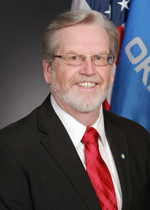By Sen. Roger Thompson
Senate Appropriations Chair
When we talk about education and appropriations, many Oklahomans think we’re only talking about K-12 schools. This week, I’d like to break down state education funding in the budget and the various agencies under the Senate Appropriations Subcommittee on Education.  While some of the entities within this subcommittee also receive federal funding, we’re going to look at the state dollars that go into education. The Education Subcommittee receives the lion’s share of all state funding—51.2 percent of the total state appropriated dollars, or $3.9 billion for Fiscal Year 2021.
While some of the entities within this subcommittee also receive federal funding, we’re going to look at the state dollars that go into education. The Education Subcommittee receives the lion’s share of all state funding—51.2 percent of the total state appropriated dollars, or $3.9 billion for Fiscal Year 2021.
The State Department of Education (SDE) accounts for 39 percent of total state appropriations, receiving just over $2.9 billion. Of that amount, $32.8 million was appropriated for the increased annual cost of flexible health benefits, and $11.7 million went for two months of the teacher pay raise that was approved in 2019. Moving forward, we must protect those commitments.
Higher Education is the next highest category in that subcommittee, receiving $770.4 million, which accounts for 10 percent of the total state appropriation. I think it’s important to point out that the average cost of mandatory tuition and fees for full-time undergraduate students is over $2,000 lower compared to other schools in the Big 12. We’re able to offer excellence in education at a competitive cost—an investment that is important to students, their families and our entire state.
CareerTech made up two percent of the state appropriation, receiving more than $137.4 million. Last year, their campuses had an enrollment of 455,124. Coupled with Higher Education, our CareerTechs are helping us increase the number of Oklahomans with post-secondary educations, increasing students’ earning potential throughout their lives, and helping grow our state’s economy.
Next, we come to the Center for the Advancement of Science and Technology (OCAST). The mission of this agency is to grow and diversify the state’s economy through technology development, transfer and commercialization. This agency received $13.7 million for the current budget year, and it’s an investment that pays dividends. Every $1 Oklahoma invests results in $22 returned to the state through wages, capital investments, and revenue growth.
$8.3 million was appropriated to Oklahoma’s Commissioners of the Land Office (CLO), which manages state assets, providing additional education funding for our state. CLO manages 750 surface acres and 1.1 million mineral acres, and more than $2.2 billion in permanent trust investments. In Fiscal Year 2020, CLO distributed $127 million to K-12 schools and higher education institutions.
Oklahoma’s School of Science and Math (OSSM) received an appropriation of $6 million. This is a public school created to give our state’s best and brightest students a college-based curriculum in a residential facility. There are 148 students currently enrolled at OSSM—all 32 faculty members hold master’s degrees and 91 percent of the faculty holds a doctorate in their academic area.
The Department of Libraries (ODL) received an appropriation of $4.3 million in the current budget. ODL serves the information and records management needs of state government, assists with public library development, coordinates library and information technology projects for the state, and serves the general public through specialized collections. In FY ‘20, 101,659 interlibrary loans were processed through ODL.
As Oklahoma works to improve our public health, having access to medical care, particularly in rural Oklahoma, is a top priority. The Physician Manpower Training Commission (PMTC) provides scholarships for rural medical residencies, physician assistant and nursing students, and provides loan repayment for physicians and physician assistants. In the current budget, PMTC received $6.9 million.
The Oklahoma Arts Council received $2.7 million in state appropriations this year, continuing their mission to boost economic development, cultural enrichment and arts education throughout our state. In FY ‘20, the Arts Council awarded 550 grants totaling more than $2.7 million to 88 communities in 49 counties throughout the state through a competitive grant process. In my own district, they help make things like the Woody Guthrie Folk Festival possible. Events like this are incredibly important for economic development in our communities.
Finally, the Oklahoma Educational Television Authority (OETA) received $2.7 million. With more than 650,000 viewers tuning into OETA weekly, it’s the most watched public broadcasting service in the country. OETA broadcasts to all 77 counties, including providing programing to rural areas that may not receive a signal from any other sources. The goal is that every citizen in Oklahoma can be informed, no matter where they live or what their income is.
Combined, these entities provide a range of educational opportunities for individuals, families and communities in the 21st century. The education dollars we appropriate are an investment in Oklahoma’s future.
If you have any questions about the budget or the appropriations process, I invite you to contact me at 405-521-5588 or email This email address is being protected from spambots. You need JavaScript enabled to view it.. Thank you.















